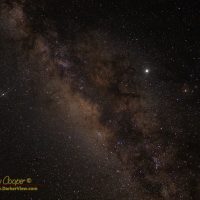I was a bit concerned as I drove to the site, a heavy fog all the way up Saddle Road persisted as I turned off on the old Saddle Road to climb the ridge to Kilohana. It was not until halfway up the gravel access road that I broke out of the fog, just a hundred yards before the Kaʻohe site.
On top of the fog it was gorgeous, a beautifully clear sky overhead with the first stars peeking out. Time to setup a telescope!
I brought the restored 8″ Cave Astrola expecting to spend the evening exploring the clusters and nebulae of the southern Milky Way in Scorpio or a bit further south. This rich region would be well positioned through the night.
We had a small group this particular evening, just six of us… Andre and Anna, Maureen, Andrew, Cliff, and myself set up by the gravel pile. There were pleasant conversations in the night, cookies and brownies to share, and views through each other’s telescopes.
One of the most pleasant surprises of the night was the seeing, in one word… Crisp. The air steady enough overhead that I took the old Astrola as high as you can reasonably go in magnification, putting a 4mm Radian in the focuser. This gives a magnification of 306x, close to the accepted maximum for an 8″ telescope.
Views of Jupiter and Saturn at high power quite nice, a lot of cloud detail showing on Jove, with little round moons flanking to either side. I had never tried this old scope at high power under decent skies. The result shows a couple things. The Cave Optical mirror is not bad, and further, my collimation job did not suck.
The site was damp, dew forming on any exposed surfaces. The folks with corrector plates were having trouble. I was glad I had thought to bring a Newtonian rather than the larger SCT, a full tube and internal mirrors just more resistant to dew. Usually Kaʻohe will dry up later in the night, not this time.
M6 A beautiful, bright cluster, a striking group that fills the field of view, bright, large, fully resolved, several dozen stars arranged in notable loops out from the center
NGC6400 A nice cluster beside the scorpion’s tail, 10′, rich, resolved, a pretty object
Collinder 338 A large coarse cluster just south of Shaula in the scorpion’s tail, large, bright, coarse, resolved, a roughly triangular grouping about 20′ across with slightly brighter stars anchoring the corners, a beautiful region rich in stars and clusters, NGC6400 just half a field east
M28 Just north of Kaus Borealis, small, bright, partially resolved, quite concentrated with a bright core, located in a rich galactic star field
With the star fields of the central Milky Way high over Mauna Loa the region was the obvious target. I put in a low power eyepiece and began to identify clusters around the scorpion’s tail. Aside from the obvious Messier objects there are any number of lesser known groups that present excellent views.
I also took along a new pair of binoculars. I recently bought a pair of small 8x42mm Nikon binos to use for travel and hiking. Despite a relatively inexpensive price, just a tad over $100, the optics are quite decent, showing good star images and pleasant views of the Milky Way. They are waterproof and nitrogen purged as well.
Collinder 316 An excellent binocular object in Sco just inside the tail, large, bright, a rich field of stars, NGC6231 visible at the southern margin
NGC6231 a tight, bright, small cluster at the southern reach of the much larger Cr316, a very pretty field for low power binoculars
M7 One of the best binocular objects in the sky, large, bright, rich, fully resolved, a field filled with stars, part of a very rich galactic star field
ω Cen Bright, not resolved, a round fuzzball in the binocular field, good sized, brighter to the center fading radially, quite easy to find
It was dew that eventually shut me down a little after midgnight. I was looking at NGC6520 and B86, noting the star field seemed a bit dim. Sure enough, the secondary was dewing over. Oh well, time to call it a night, even if I was awake enough to keep going.





Thanks for the great report, shucks missed debs cookies.
Aloha
Well? The cookies were just store bought Oreos this time. I brought the s’mores flavor. Maureen outdid me and brought the Apollo anniversary Oreos with astronauts and lunar landers on them, in a glow in the dark package 🙂